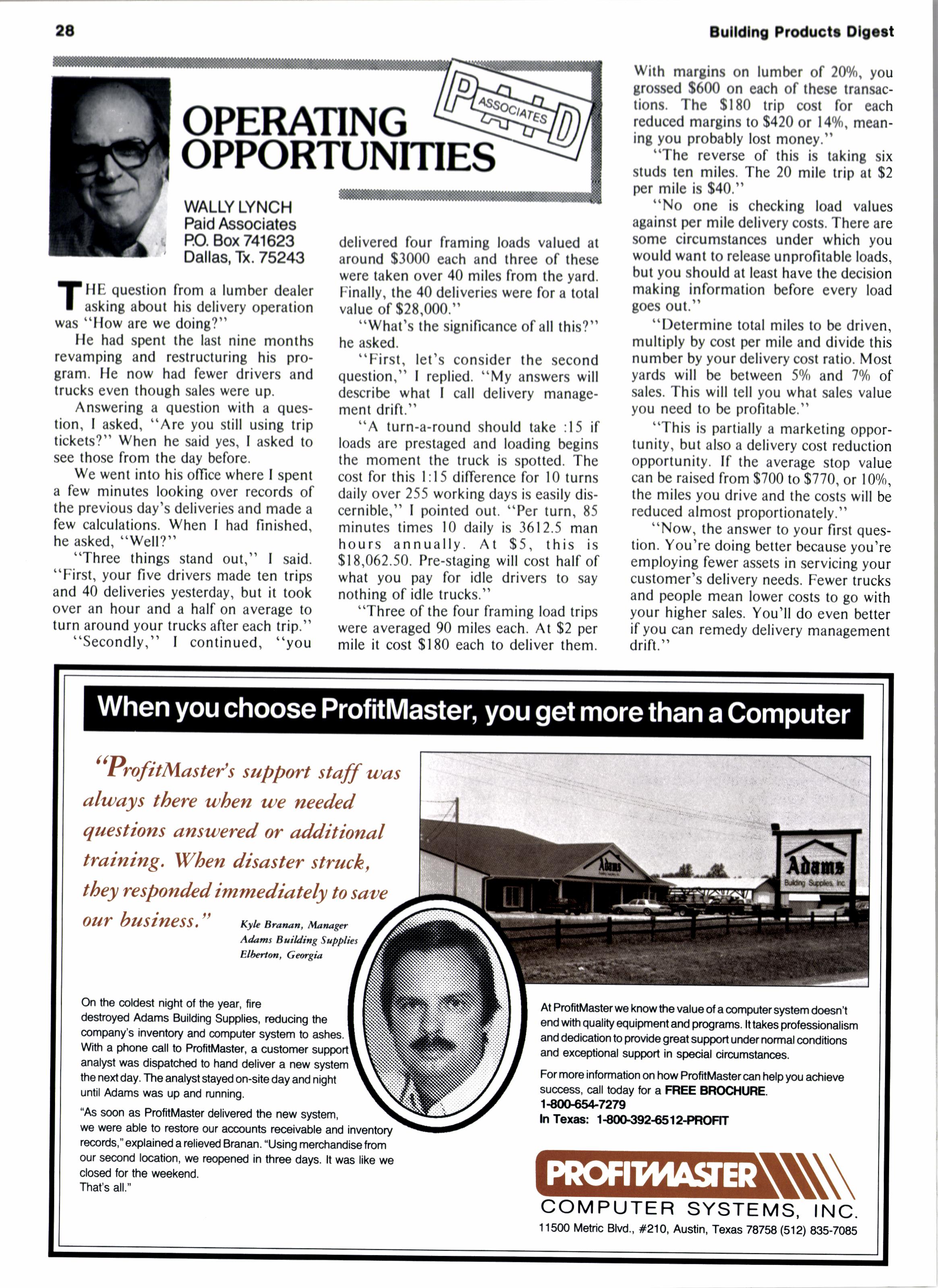
2 minute read
OPERATING OPPORTUNInES
Wallylynch
Pald Associates
PO. Box741623 Dallas, Tx.75243
THg question from a lumber dealer I asking about his delivery operation was "How are we doing?"
He had spent the last nine months revamping and restructuring his program. He now had fewer drivers and trucks even though sales were up.
Answering a question with a question, I asked, "Are you still using trip tickets?" When he said yes, I asked to see those from the day before.
We went into his oflice where I spent a few minutes looking over records of the previous day's deliveries and made a few calculations. When I had finished, he asked, "Well?"
"Three things stand out," I said. "First, your five drivers made ten trips and 40 deliveries yesterday, but it took over an hour and a half on average to turn around your trucks after each trip."
"Secondly," I continued, "you delivered four framing loads valued at around $3000 each and three of these were taken over 40 miles from the yard. Finally, the 40 deliveries were for a total value of $28,000."
"What's the significsnce of all this?" he asked.
"First, let's consider the second question," I replied. "My answers will describe what I call delivery management drift."
"A turn-a-round should take :15 if loads are prestaged and loading begins the moment the truck is spotted. The cost for this l:15 difference for l0 turns daily over 255 working days is easily discernible," I pointed out. "Per turn, 85 minutes times l0 daily is 3612.5 man hours annually. At $5, this is $18,062.50. Pre-staging will cost half of what you pay for idle drivers to say nothing of idle trucks."
"Three of the four framing load trips were averaged 90 miles each. At $2 per mile it cost $180 each to deliver them.
With margins on lumber of 2096, you grossed S600 on each of thcse transactions. The $180 trip cost for each reduced margins to $420 or t4%, meaning you probably lost money."
"The reverse of this is taking six studs ten miles. The 20 mile trip at $2 per mile is $40."
"No one is checking load values against per mile delivery costs. There are some circumstsnces under which you would want to release unprofitable loads, but you should at least have the decision making information before every load goes out."
"Determine total miles to be driven, multiply by cost per mile and divide this number by your delivery cost ratio. Most yards will be between 50/o and 70/o of sales. This will tell you what sales value you need to be profitable."
"This is partially a marketing opportunity, but also a delivery cost reduction opportunity. lf the average stop value can be raised from $700 to $770, or 100/0, the miles you drive and the costs will be reduced almost proportionately. "
"Now, the answer to your first question. You're doing better because you're employing fewer assets in servicing your customer's delivery needs. Fewer trucks and people mean lower costs to go with your higher sales. You'll do even better if you can remedy delivery management drift."
On the cold€st night of th€ year, fire destroy€d Adams Building Supplies, reducing the company's inventory and cofitprJtsr s)6tem b ashes. With a phone call to Prollf\rast€r, a customer support analyst was dispatched to hand delivsr a new systom th€ next day. Th€ anal)rst stayed on-silo day and night until Adams was up and running.
"As soon as ProfitMaster delivered the ne$/ s)6tem, ur€ urer€ able to r€stoE our a@ounts receivable and inventory r€cords," explain€d a relieved Branan. "Using m€rcfiandiss from our se@nd localion, lw rsop€ned in three days. lt was like we closed for the weekend. That's all.'
At Prcfi$rastor we knol the value of a cornputer systom do€sn't end wih quality equiprn€nt and Fograms. lt takes protossionalism and dedicalion to provil€ gr€at support und$ nonnal conditions and exceptional support in sp€cial cirujmstanc€s.
Formore information on ho/Y ProfitMaslercan helpyor.l achieve succ€ss, call bday b,r a FREE BROC+IURE. 1{X}6r!r-7271 h Texas: 1$G39|16512+ROFIT










